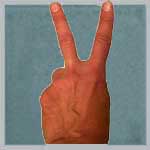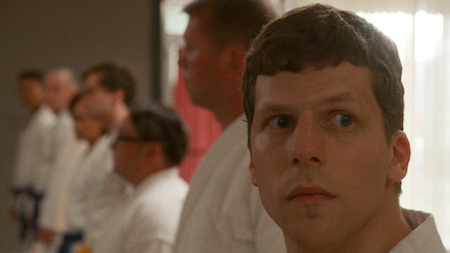Art of Self-Defense
 Sometimes I’ll sneak into a kegger at a house by the college. I’ll stand silently in the corner pounding down free Natty Ice until my body screams, “Enough!” and launches a ripe, wet vapor-turd in rebellion. That wet fart will linger over the living room long after the frat bros realize I didn’t pay ten bucks to get in and kick me out. Also, that I’m way too fucking old to be there, and I’m wearing a woman’s wig. I may have been forgotten, but the bitterness of efforts keeps burning nostrils and stinging tongues.
Sometimes I’ll sneak into a kegger at a house by the college. I’ll stand silently in the corner pounding down free Natty Ice until my body screams, “Enough!” and launches a ripe, wet vapor-turd in rebellion. That wet fart will linger over the living room long after the frat bros realize I didn’t pay ten bucks to get in and kick me out. Also, that I’m way too fucking old to be there, and I’m wearing a woman’s wig. I may have been forgotten, but the bitterness of efforts keeps burning nostrils and stinging tongues.
The ideas from phony-ass intellectuals are like those wet farts. Some guy who read the first thirty pages of Kant once and stopped because he “got the gist” bombs the room and leaves. He probably never thinks about it again, just moving on to the patio and a different discussion about how Europe is better or how he doesn’t even own a TV while the rest of us are left to marinate in his waste, to sort through the dumbness, wrongness and smugness of his proclamations.
The Art of Self-Defense is that philosopher’s wet fart. A real stinker, a rotten egg of a movie. All its press materials say it’s about toxic masculinity, which I think the current way to describe dudes with giant trucks and decals that say “Wayne” on the driver window and “Some Stupid Bitch” on the passenger one. Guys with tiki torches in their closet and who still think telling women to “make me a sandwich” is hilarious.
Those guys are not what this movie is about. Toxic masculinity is not what this movie is about. At least, not in any insightful or clever way. People say that’s what the movie’s about because it’s the closest neighborhood to the nowhere this thing is. The Art of Self-Defense is the work of a phony intellectual and the strawmen he dreams up, all the non-existent people with whom he does verbal battle in his mind. They are simple, they are wrong-headed, and they are easily convinced that the philosopher is right.
Everything in it feels easy, obvious and contrived, without reflecting real life, real emotions or how people really interact. That can be okay, or even great, but not here. And that’s because it doesn’t feel like it’s fakeness says less about reality than it does about how the writer-director Riley Stearns doesn’t really understand it and only has something to say about the simplistic version of it he imagines.
In casting that’s a little too on the nose, Jesse Eisenberg plays a nebbish, awkward accountant (of course an accountant) named Casey who gets mugged by bikers one night while getting dog for his little dog. This causes him to confront his own weakness and fear. He is drawn to a strip mall karate school led by a weirdly intense sensei (Allesandro Nivola) who keeps secrets and a tight rein on his students.
Eisenberg finds the testosterone-fueled brotherhood he sought, but also the dark underbelly of fraternity. That is that the other students are bonded by the weird demands of the sensei, who has videotaped them doing violent things and then blackmailed them for money. In a twist as shocking as that the bad-boy carpenter in a Hallmark Christmas movie actually has a heart of gold, it was the sensei and his blackmailed band of thugs who mugged Casey to begin with. Ah, the circle of life.
 It is only after doing several vile things that turn Casey from uninteresting to irredeemable that he fights back. Even his revenge is dissatisfying, though, and predicated more a checklist of by bad ideas than any sense of closure or narrative. Casey’s hates the sensei for the violence he’s preached, so his revenge is to kill him. Also, to kill one of the thugs who was blackmailed into doing awful shit just like he was. It’s as though Stearns is so fucking impressed with simple ideas that he doesn’t connect them or even consider what he is trying to say with all of it.
It is only after doing several vile things that turn Casey from uninteresting to irredeemable that he fights back. Even his revenge is dissatisfying, though, and predicated more a checklist of by bad ideas than any sense of closure or narrative. Casey’s hates the sensei for the violence he’s preached, so his revenge is to kill him. Also, to kill one of the thugs who was blackmailed into doing awful shit just like he was. It’s as though Stearns is so fucking impressed with simple ideas that he doesn’t connect them or even consider what he is trying to say with all of it.
The movie is low-budget and drab, but not in any visually interesting way. It is played for deadpan, but not really to any effect. The monotony feels more like a style choice that was made long before the story was written, a cool, detached way to do it.
The Art of Self-Defense takes place in fictitious places that feel incomplete, generic derelict city streets and concrete offices. They are unpleasant, but not put to good use. Similarly, the story takes place in some pre-Internet 1990s, most likely not because it has something to say about that time, but because the 90s are the easiest and cheapest way to tell a story where characters have no cell phones or computer access to shitloads of information. The movie is not commenting on masculinity 25 years ago, so what the fuck?
The movie is littered with incomplete ideas, things that don’t fit well together, but were in Stearns’ head and so he farted them out and left us to stew in them. Things like the sensei having an incinerator in his school for burning bodies, the sensei never shows a care for money and yet blackmailing students for it. For fuck’s sake, is there any longer yardstick for measuring masculinity nowadays than wealth? Very few of Casey’s choices make sense, or even deepen the story. He is a profoundly dull protagonist who shows few smarts and no soul. Because of the deadpan delivery, even the things he does that make us squirm elicit little regret or joy from him. There just isn’t enough of him there to make me give a shit.
The attacks on “Toxic Masculinity” are the sort of dumb and easy targets like feminine male names like Casey and Leslie. The movie certainly doesn’t dig deep to get at the root or of it, or at least come up with relatable examples. What about the obsession with dick size or height, or anything else people have no control over?
Also, for a movie about the dangers of being too male, the movie sure as fuck lacks for estrogen. There is one woman (Poots), and she is ill-defined. To be fair, there is equality; she’s just as fucking boring as everyone else.
So, the Art of Self-Defense is a fart of a movie. The thing about farts, though, is most people don’t mind their own. In fact, director Stearns is probably pretty fucking proud of this one. And that's the problem. Two Fingers.
